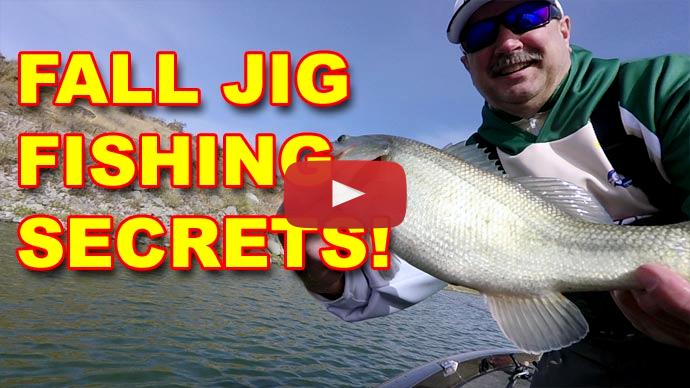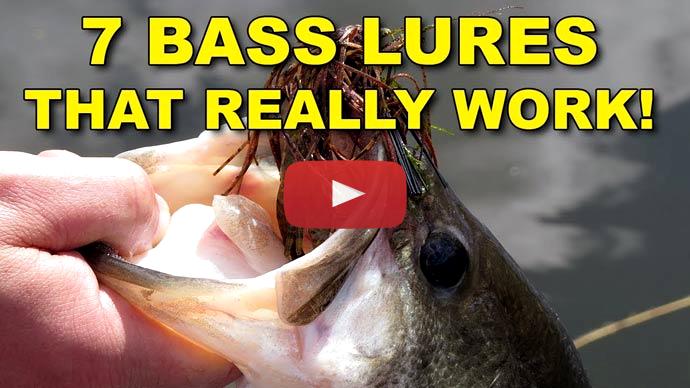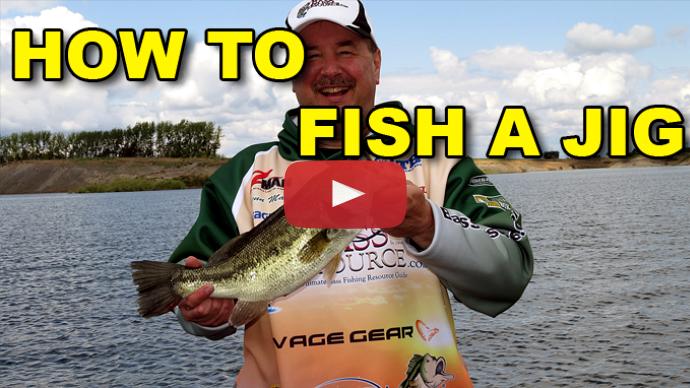Hey guys, Cliff Pirch here with bassresource.com, and we're talking fall fishing. So, when I'm talking fall fishing regarding jig fishing, things get a little bit tricky. Because, for one, in the fall, the fish start to get all over the place. You might have a population of fish in 2, 1 to 3 feet, you might have another population of fish in 30, 40, 50. So, in the fall, the bass tend to spread out, the bait spreads out and the bass, you know, follow that food. So, if you're on a type of fishery where they start to go deep or if you're fishing for deep fish, there's a number of things that work well for those deep fish. You know, I might be using a spoon, a drop shot, a deep crankbait, maybe an Alabama rig.
There's all kinds of deep tools, but if I want to specifically target some of those biggest bass in those deep schools, a lot of times I'm gonna go for a jig, I wanna use that deep football jig. That means like a 3/4 ounce, 1 ounce, sometimes that will get the best bass in the school a bite.
And, you know, just in my experience, maybe 10 or 12 years ago I got, one of my biggest wins in my career was on a football jig in the fall at Clear Lake. I won the tournament on the final day, and one of the best days I've ever had. My biggest tournament weight that I've ever weighed was 37 1/2 pounds and in an FLW event, it set the Western record for one-day weight at that time. And just one of the most memorable days of my career, but I did it all on a 3/4 ounce football jig.
And, now those fish would bite some other things, and there was lots of 20 pound bags coming in. But in order to get those 7, 8, 9, 10, 11 pounders to bite, the jig was the ticket. One, it doesn't have all that vibration and flash that smart old fish get accustomed to and they shy away from. The jig, it's just super natural and big fish tend to still bite the jig even when they get old and smart. So, the jig tends to select for that big fish. And that's why I am gonna lean towards using a, maybe a 3/4 ounce, 1 ounce football jig in the fall. That's for those fish that get offshore on the deep rocks, you know.
At Clear Lake, for instance, they were on deep rocks, it was deep. I think volcanic, big volcanic and chunk rock breaks. And those big fish would get around those boulders, and that particular jig, you know, when it's 3/4 ounce, 1 ounce, real heavy, what it does is it falls quick, you know, from ledge to ledge right there. And they're gonna be tight to those big rocks. And when a bluegill or a crawdad or something like that makes a mistake, they've got a short run to grab it. And that's exactly what this looks like, you know, it kind of contours the rocks because it's heavy and it falls, you know, you drag it off and it falls by them, falls by them, falls by them. And so, really a good way to trigger those big fish to bite.
Now, on the other hand, sometimes in the fall and fishing shallow, there were some tournaments, oh, it's been a long time ago now, but I won three or four boats fishing, shallow, shallow cover in the fall. Because those, the biggest bass in the lake had gotten up into some flooded mesquite bushes and salt cedars. And instead of chasing bait and really burning a lot of energy like a lot of fish do in the fall, the biggest fish still were kind of hunkered down in the cover, and they were feeding on crawdads and bluegills. So, the flipping jig, again, it's a super-efficient way to get through cover and not get hung up, but to be putting your bait where the big ones live, it's really hard to get a crankbait in there.
You know, sometimes you can get a buzz bait or a top water over the top of it, but, you know, when they are buried in that cover and they don't wanna come to the surface, a flipping jig is just a good way to get them. And it gets the big fish, and it's able to, again, target the specific deep piece of cover that they're in. So, I'm gonna opt for that jig. It's gonna give me a good chance to catch the biggest fish in the area. You know, the little shad chasers, yeah, everybody's gonna weigh those in. But if I need the five biggest bass that I'm going after, a jig is gonna select for that big one. I'm able to get that 3 pounder, that 5 pounder. Those fish that are little less likely to be roaming, and they're gonna own a piece of cover, that flipping jig.
So, again, when we're talking about jigs and fall fishing, we've got all kinds of extremes, because those fish tend to move throughout the water column. There's a lot wider range of depths that bass will be in. So, you've gotta kinda find the evidence on the body of water you're on, you know, what level of water you're fishing. But targeting them with the jig, a lot of times will get your biggest bite, will get your biggest bite. So, that's fall fishing with the jigs.
Okay. As far as tackle goes, when I'm fishing jigs in the fall, I'm gonna use some specific differences between my flipping jig and my football jig. My football jig, both of them are gonna be heavy action. You know, when you're fishing a jig, you're really setting the hook, so I want heavy action. As far as my football jig goes, this is a 7'7" extra heavy Feather from Phenix Rods. I'm able to cast a long ways, that 7'7", I really like it, and I wanna get that football jig way out there. The other thing is I gotta move a lot of lines, so I like a long rod. You know, some guys are really comfortable with a 7 footer. I really, if I can get away with 7 1/2, I really like it a lot better. It moves a little bit more line, and that's important when you've got a long cast out there. You might have a little bow and current, might have some wind, it just helps you move that line, so, extra heavy action.
As far as my line goes, I want 15 to 17-pound test most of the time in the fall, because I'm fishing deep. With a football jig, 15 to 17 gives me a chance to get it down there and still have the power to wrestle those great big fish. So, I don't wanna be going real light, I don't wanna be going super heavy. You tend to get more buoyancy in your line and it doesn't wanna give you quite the sensitivity. So that 15 to 17-pound range works good and works good for my football jig. And again, that's the 7'7" extra heavy.
Now, as far as my flipping rig goes, I'm using totally different gear. I'm gonna go with the 7'11", and it's a heavy action flipping rod, it's the Super Flipper from Phenix. Again, powerful hook set, but this one I've got rigged up with braid and a fluorocarbon leader. I got about a 3-4 foot leader on here, I just don't like them to get a real clear look. Now, if you've got muddy water, dirty water, not good clarity, you can get away with straight braid. But I feel like I can get a few more bites by going to that fluorocarbon leader of 20 to 25-pound test, that way, they can't see it. You know, jig, especially the flipping jig, it's not moving real fast. Now, you can move it kind of fast, but they're gonna get a pretty good look at it, so I would prefer to get that fluorocarbon leader on there and just cut out the fish that are gonna see there's something a little unnatural, or I can see that line. I wanna use that fluorocarbon leader.
But, again, I'm gonna use a heavy action rod. It's a flipping stick 7'11", I wanna be able to sling them out of the cover. It's a quick hook set. You know, a lot of times it's a short pitch or a skip under a limb and you're short range fishing. So that big heavy rod gives me power, you know, it's two or three cranks in the reel and I'm swinging the bass in the boat. So, that's kind of my gear for it.
Both are a fast retrieve ratio on my reels. I want speed when I'm winding, you know. Whether it's taking up a lot of line on a football jig or my flipping jig, I wanna be able to, you know, make those two or three cranks quick and swing that bass in the boat.
So, as far as gear goes, those are my rod setups.
And, you know, again, that's fall jig fishing 101. There's just so much variety in the fall that it's hard to do any one thing until you kind of isolate the depth zone you're targeting.



